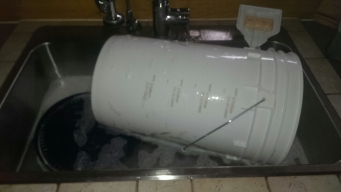Not long ago I read a rant by someone who was (rightly) complaining about the poor quality of the ingredients you find in store-bought beer. I thought I would post how I brew my beer so that people could see how simple it really is. It’s also cheaper!
The beer I brew, which is about as complicated as baking bread or a batch of cookies, easily rivals the more expensive beers you can buy in the store. So here we go!
I got my recipe from the people at the store where I buy my ingredients. I start with fresh water. I add 4 cups of rolled barley (I buy organic barley in bulk) to a sock that acts like a tea bag. Then I steep the barley in water that is almost boiling for 30 minutes. Once I have this started, I get out the yeast so that I can bring it to room temperature and I clean and disinfect the primary fermenter.
Brewing beer is similar to making cheese. You must make sure your utensils are extremely clean so that you don’t introduce unwanted yeast or bacteria to your product. Just so you know, the worst that can happen is that you spend money brewing a batch of bad beer. To my knowledge, no one has suffered from food poisoning from a bad batch of beer. You do suffer a financial loss, though, something I think we all want to avoid.
In addition to water, these are the only ingredients you need to successfully brew a good batch of beer: yeast, grains (in this case, barley), a malt extract, corn sugar that you will use later, right before you bottle your beer, and hops.
After you have cleaned and disinfected your primary fermenter and steeped the barley, the next step is to add the malt extract and hops to the barley “tea” and boil your wort. Depending on the recipe, different types of hops are added at different points during the period where your wort is boiling.
When this is finished, you need to cool your wort to room temperature by putting it in an ice water bath so that you can add the yeast without killing it. Just so you know, I have added yeast to wort that was as warm as 95° Fahrenheit and the beer did not suffer. I was just too impatient to wait for it to come down to the prescribed 70° Fahrenheit.
After the wort is cooled, I add more cold water so that the batch comes up to 5 gallons. I then add the yeast, give it a good stir and put the fermentation lock on top of the lid of the primary fermenter. This allows gas to escape without letting wild yeast into your brew. Now I just sit back and wait for it to ferment a little while. In about week, I will move the beer into the secondary fermenter. It will ferment for about a week longer before I bottle it. I’ll post another article on the racking and bottling process.
For those of you who are interested in getting started brewing your own beer, you can purchase everything you need for around $150. Each successive batch costs me between $30 and $50 for a five gallon batch, roughly equal to the amount of beer in two cases.
Brewing beer can be much more complicated than the process I have outlined here. A real food purist might want to grow his own hops. He might want to make his own malt extract instead of having it done for him, sort of like baking a cake from scratch instead of using a mix. He might want to experiment with different grains, different yeasts, different brewing processes. But if you are incurably lazy like I am, you can brew really tasty beer with very little effort.
And for my Catholic friends who prefer to drink blessed beer, here is a link to a blessing for beer. 😀
I am writing this post with the intent to give hope to other amateur gardeners. This is probably the worst gardening year I have ever had. I have completely lacked enthusiasm, the weather hasn’t been too cooperative, weeds are starting to get out of control and whatever I have planted has gone in late.
A couple of years ago, a fellow gardener donated some extra strawberries from his garden to me. I received them in a 5 gallon bucket and dutifully put them in the ground in the garden on the east side of our property near the house. I love fresh strawberries and I hate weeds and I thought this would be the perfect way to have my cake and eat it too. They are thriving despite the rather brutal weather conditions we’ve had here: wind and frigid temperatures in the winter and drought in the summer.
At the time I planted these, there were five scraggly plants at the bottom of the bucket that I didn’t have the heart to throw away, so I threw them into our south garden in an empty spot without much hope they would survive. Out of the five, only one made it, but here is what it looked like this morning.
Look at what that one pathetic plant has turned into! It is now a force the weeds must reckon with! I must confess that I share this picture with shame. This garden has been seriously neglected. On the other hand, it has been interesting to observe just how productive it is with absolutely no help from me. This is the second year that we have had volunteer lettuce and chives. I think I’ve put about an hour’s worth of weeding in this year, just to give the lettuce a little room.
So, I have discovered that with almost no effort, I will have lettuce and chives from my garden this year, that because the strawberries are taking over, I won’t need to weed as much, and that the weeds which used to be the bane of my garden have now yielded to a new ground cover yielding delicious surprises. Moral of the story? You may give up on your garden, but it may not give up on you!








